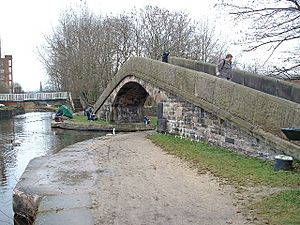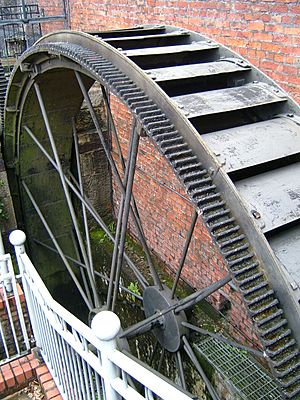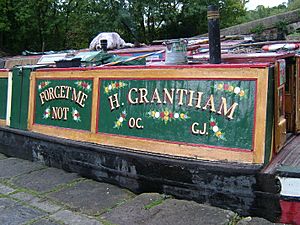Dukinfield Junction facts for kids
Dukinfield Junction is a special place where three canals meet. It's like a watery crossroads! These canals are the Peak Forest Canal, the Ashton Canal, and the Huddersfield Narrow Canal. You can find this junction near Ashton-under-Lyne in Greater Manchester, England.
Right next to the junction is an area called Portland Basin. Many boaters use "Dukinfield Junction" and "Portland Basin" to mean the same thing. However, locals usually just say "Portland Basin." Technically, Portland Basin is the wider part of the main canal. The section under the junction bridge and the aqueduct (a bridge that carries water) over the River Tame were built by the Ashton Canal. The Peak Forest Canal officially started at the end of this aqueduct.
Contents
Canals: A Look Back in Time
Canals were like the motorways of the past. They helped move goods around the country. Let's learn about the three canals that meet at Dukinfield Junction.
The Ashton Canal: Connecting Towns
The Ashton Canal was approved by a special law in 1792. Its main job was to link the coal mines near Oldham and the textile factories in Ashton-under-Lyne to the big city of Manchester. This canal had many locks – 18 of them in about 6.5 miles (10.5 km)! Locks are like water elevators that help boats move up or down hills.
While building the main canal, the company got permission to add more branches. These included the Hollinwood Branch Canal and the Stockport Branch Canal. The main line to Ashton and the Hollinwood branch opened in December 1796. The Stockport Branch opened a month later in January 1797.
The Peak Forest Canal: Moving Limestone
The Peak Forest Canal was approved two years after the Ashton Canal. Its purpose was to reach valuable limestone quarries at Doveholes, near Whaley Bridge. The last 6.5 miles (10.5 km) of the journey were done by a special railway called a tramway. This was because the quarries were too high up for the canal to reach easily. Limestone was then moved onto barges at Bugsworth Basin.
Most of this canal opened in 1800. However, a set of locks at Marple wasn't finished yet. So, a temporary tramway was used to bypass these locks for four years. The Ashton Canal built a short section south from the junction, including an aqueduct over the River Tame. The Peak Forest Canal officially began at the southern end of this aqueduct.
The Huddersfield Narrow Canal: Crossing the Pennines
The Huddersfield Narrow Canal was also approved in 1794. It's one of three canals that cross the Pennines, a range of hills in northern England. Building it was a huge challenge! It has 74 locks and the longest canal tunnel in Britain, called Standedge.
Parts of the canal opened as they were finished. The section from Ashton to Greenfield opened in 1798. But the whole canal wasn't fully open until 1811, when the long tunnel was finally completed. This canal meets the Ashton Canal right at the junction.
Bringing the Canals Back to Life
Over time, canals became less used as roads and railways improved. The Huddersfield Narrow Canal was officially closed in 1944. The Peak Forest Canal stopped being used by boats around 1939, just before the Second World War. By 1962, the Ashton Canal was also no longer usable.
But people wanted to see these historic waterways brought back to life! The Peak Forest Canal Society was formed. They worked with the British Waterways Board and local councils. Thanks to their efforts, the Ashton Canal and the lower part of the Peak Forest Canal were reopened in 1974. This meant Dukinfield Junction was busy with boats again!
The campaign to restore the Huddersfield Narrow Canal also began in 1974. This was a much bigger project, but it finally finished in 2001. Public money from the Millennium Commission helped make this possible.
The Ashton Canal Warehouse
The Ashton Canal Warehouse was built at Portland Basin in 1834. It replaced an older warehouse. This large building is three storeys high and measures about 200 feet (61 meters) by 72 feet (22 meters). It's made of brick, and its wooden floors are held up by strong cast iron columns.
The side of the warehouse facing the canal was three storeys tall and had three openings for boats. The side facing the road was two storeys high. Special trap doors allowed goods to be loaded and unloaded from both the road and the canal at the same time. The roof was flat, which meant even more storage space. The warehouse you see today was restored in 1998.
The Amazing Portland Basin Waterwheel
Inside the warehouse, a hoist system was used to lift goods. This system was powered by a large waterwheel located outside the building. Water from the canal flowed to the wheel, and then the used water flowed down to the River Tame, about 33 feet (10 meters) below.
This impressive waterwheel was built in 1841. It was 24 feet (7.3 meters) in diameter and 3 feet (0.9 meters) wide. It could produce about 15 horsepower (11 kW) of energy! The power was sent through a "line shaft," which is like a long spinning rod. This special design made the wheel lighter than older wooden ones. Taking power from the rim of the wheel, rather than the center, also made it more efficient.
Portland Basin Museum
Today, the restored Ashton Canal Warehouse is home to the Portland Basin Museum. This museum tells the story of the area's industrial past. You can explore a recreated 1920s street with shops, see rooms set up from different time periods, and discover old machines. It's a great place to learn about local history, industries, and trades.
The Wooden Canal Boat Society
Portland Basin is also home to the Wooden Canal Boat Society. This group works to restore and use six traditional narrowboats. These are long, thin boats designed for canals. The Society started in 1996 and became a registered charity in 1998. Their first boat arrived at Portland Basin Museum in 1996. They help keep the history of canal boats alive!
Finding the Junction
The junction is on the southern edge of Ashton-under-Lyne. The Ashton Canal comes from the south-east. This canal is flat for about 2.5 miles (4 km) until it reaches Fairfield Junction. From there, the Fairfield locks begin the descent to Manchester.
The Peak Forest Canal heads south from the junction. It's flat for about 7 miles (11 km) before reaching the first of the sixteen Marple Locks. This canal also goes through two short tunnels at Woodley and Hyde Bank. The Hyde Bank tunnel is a bit narrow, so two boats can't pass each other inside.
The Huddersfield Narrow Canal goes north-east from the junction. It passes under an Asda supermarket in a tunnel. Then, it reaches the first of 32 locks that climb up to the Standedge Tunnel, which is about 0.4 miles (0.6 km) from the junction.
A slim bridge carries the towpath (the path next to the canal) over the line to the aqueduct and the Peak Forest Canal. This bridge has the date 1835 on it and is a grade II listed structure, meaning it's historically important.
Nearby is Cavendish Mill. This old cotton spinning mill was built in 1884-85. It was one of the first buildings to use steel girders and concrete floors, which was a new way to build at the time.
Every year in mid-July, the Tameside Canals Festival is held at Dukinfield Junction. It's a fun event that celebrates the canals and their history!
Images for kids







